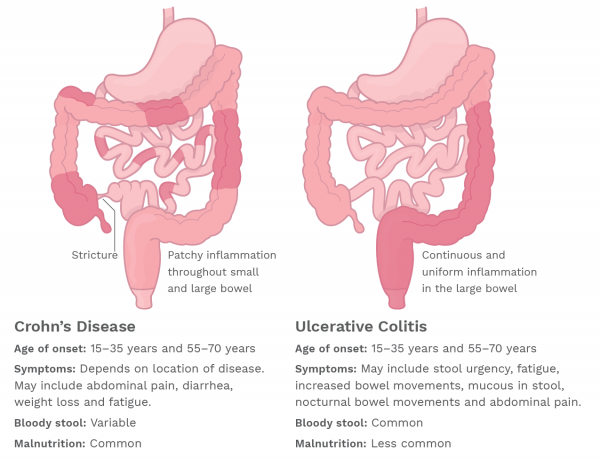How Is the Family of a Person With Crohn's Affected?
Overview of Crohn'due south Affliction
Crohn's disease is a chronic inflammatory condition of the gastrointestinal tract. Understanding Crohn's disease tin can help you lot and your loved ones navigate the incertitude that comes with a new diagnosis.
Calling all Crohn's patients! Have you or a loved one been recently diagnosed? Or were you diagnosed with Crohn's disease years ago but still don't fully sympathise your disease? Bank check out our latestvideo chat to larn more than.
Crohn's disease belongs to a group of conditions known as inflammatory bowel diseases, or IBD. It is named after Dr. Burrill B. Crohn, who kickoff described the affliction in 1932 along with his colleagues, Dr. Leon Ginzburg and Dr. Gordon D. Oppenheimer.
Who is Affected?
-
IBD affects an estimated 3 million Americans. Men and women are equally likely to be affected by Crohn's affliction.
-
The disease can occur at any age, but Crohn's disease is most oftentimes diagnosed in adolescents and adults between the ages of 20 and 30.
-
Studies have shown that between one.5 percent and 28 percent of people with IBD take a first-degree relative, such as a parent, child, or sibling, who also has 1 of the diseases.
-
Fifty-fifty though in that location is genetic component associated with increased risk of IBD, information technology is incommunicable to predict who may get Crohn's disease based on family history.
-
Crohn'due south affliction tin affect people from all ethnic backgrounds. The disease is more common in Caucasians, though the rates of Crohn'due south disease take increased amidst Hispanics and Asians in recent years.
Crohn'due south Illness
-
Can affect any part of the GI tract from the mouth to the anus, but most commonly affects the end of the pocket-size bowel (ileum) and the commencement of the colon
-
Tin can affect the unabridged thickness of the bowel wall
-
Inflammation of the intestine can "skip," or go out normal areas in between patches of diseased intestine
Ulcerative Colitis
-
Just the colon, also called the large intestine, is affected
-
Affects only the innermost lining of the colon
-
Inflammation of the intestine does not "skip"
Types of Crohn's Affliction
If you are diagnosed with Crohn's disease, it's of import to know which part of your GI tract is affected. While symptoms of Crohn's illness can vary from person to person, the type of Crohn's you lot take impacts the symptoms and complications you may experience.
Ileocolitis
This is the most common form of Crohn's disease. Information technology affects the terminate of the pocket-sized intestine, known as the terminal ileum, and the large intestine, also called the colon.
Symptoms may include:
-
Diarrhea and cramping
-
Pain in the center or lower right office of the abdomen
-
Pregnant weight loss
Ileitis
This type of Crohn'due south affects merely the ileum.
Symptoms may include:
-
Same equally ileocolitis
-
In severe cases, complications may include fistulas or inflammatory abscess in the correct lower quadrant of the abdomen
Gastroduodenal Crohn'southward Disease
This type affects the breadbasket and the beginning of the minor intestine, called the duodenum.
Symptoms may include:
-
Nausea
-
Vomiting
-
Loss of appetite
-
Weight loss
Jejunoileitis
This blazon is characterized by patchy areas of inflammation in the upper half of the minor intestine, called the jejunum.
Symptoms may include:
-
Mild to intense abdominal hurting and cramps following meals
-
Diarrhea
-
Fistulas may form in severe cases or after prolonged periods of inflammation
Crohn'south (Granulomatous) Colitis
This type affects merely the colon, as well known as the large intestine.
Symptoms may include:
-
Diarrhea
-
Rectal bleeding
-
Disease effectually the anus, including abscess, fistulas and ulcers
-
Skin lesions and joint pains are more common in this form of Crohn'due south than in others
Crohn'south Disease vs. Ulcerative Colitis
Crohn's illness and ulcerative colitis share similar symptoms and they are both types of inflammatory bowel illness (IBD), but they are not the same disease and they affect unlike areas of the GI tract.
Crohn's disease
- Tin affect whatsoever part of the GI tract from the oral cavity to the anus
- Can touch the entire thickness of the bowel wall
Ulcerative colitis
- Only the colon and rectum (too known as the big intestine) are affected
- Affects the inner-most lining of the large intestine
Related Resources
Text article
Crohn's & Colitis Glossary ...
Anti-OmpC (outer membrane protein C): the antibody to a specific protein on the outer membrane, recently identified as a meaning biomarker. Ne...
Source: https://www.crohnscolitisfoundation.org/what-is-crohns-disease/overview

0 Response to "How Is the Family of a Person With Crohn's Affected?"
Post a Comment